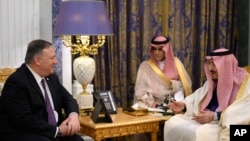U.S. Secretary of State Mike Pompeo met Thursday with Saudi Arabia's King Salman, visited Saudi defense installations and kept the focus on Iran's threat to regional security. Saudi media highlighted the U.S. finding that Iranian missiles being provided to Tehran's Houthi allies in Yemen were used to attack Saudi oil installations last year.
The Saudi news channel showed U.S. Secretary Pompeo meeting with King Salman, along with a delegation of top U.S. officials.
Saudi media did not play up a similar meeting later in the day between the secretary and Crown Prince Mohammed Bin Salman, the focus of continuing U.S. congressional ire over the 2018 killing of Saudi journalist Jamal Khashoggi at the kingdom's Istanbul consulate. Pompeo reportedly also met with Saudi Defense Minister Khaled Bin Salman.
Pompeo visited the strategic Prince Sultan Airbase, where the U.S. has stationed fighter jets and U.S. forces, following a defense build-up in the wake of Iranian missile and drone attacks on Saudi oil installations last year. U.S. Patriot missile batteries were also deployed near the base.
Commentator Mohammed Sa'ad of the Saudi daily Okaz told Saudi media Pompeo's visit shows that both Washington and the West consider Riyadh an important player in countering Iranian expansion in the region.
He said Iran has turned the region into a powder-keg for the last 40 years, due to efforts to export its so-called revolution, spreading conflicts, blood-shed, terrorism and extremism.
He added that the strategy to counter Iran recently changed after a U.S. drone strike killed top regional commander Gen. Qassem Soleimani, a driving force behind Iran's aggressive policies.
Dr. Paul Sullivan, a professor at the U.S. National Defense University, tells VOA the U.S. finding that Iranian missiles were sent to the Houthis and used against Saudi targets "is not exactly surprising." Yemen, he says, "is a desperately poor and shattered country full of frustrated and angry young men." He added: "It is fairly easy recruiting territory for Iran and its enablers."
The Saudi-led coalition, which has been battling the Houthis since its military intervention in Yemen began in March 2015, has been unable, so far, to dislodge them from the capital, Sanaa, and restore exiled President Abdrabbu Mansour Hadi as leader of the entire country.
Sullivan went on to stress it is easy for Tehran "to pay off smugglers and criminals to move weapons around the region." He argued, "The dark forces of the weapons trade fit well into Iran's nefarious strategies."
Washington-based Gulf analyst Theodore Karasik told VOA that "Pompeo's visit to both Saudi Arabia and Oman is meant to bring further attention to the issue [that] Iranian maritime and land smuggling routes remain active supporting the Houthis."
Karasik added that Pompeo is due to raise the subject with Oman's new Sultan Haitham Ben Tareq, following the death of Sultan Qaboos and the traditional 40-day mourning period.











